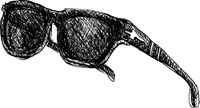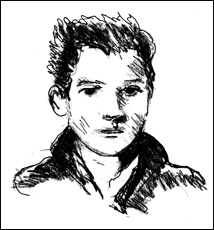

This film invented foreign films. Marcello Mastroianni is a jaded reporter in this wildly prescient ride through Rome in 1960. Religious mania, aggressive TV crews, the shallowness and bitterness of free sex and glamorous living, the sterility of success, and impending suicide are all examined by the keen eye of Fellini. This movie introduced paparazzi. The film is a series of episodes strung together in the life of our hero. He sails and swings and dallies and gets punched—literally and metaphorically. The costumes and settings are not to be forgotten. Sunglasses indoors at night, bambino. The voluptuous Anita Ekberg does a dance in the Trevi Fountain that is so invigorating it cannot be forgotten. (Evidently, she was cool with being in the freezing cold while they shot; Marcello was freezing and had to drink a bottle of vodka and wear a wetsuit underneath.) La Dolce Vita still stings and rings true. Fellini shows you the tragedy of our world of vapidity while making everything look hip and beautiful. Required.

A film most pertinent in this time of mass eavesdropping and surveillance, The Lives of Others is a moving and horrifying look at the police state and the inevitable corruption of those doing the spying. East Germany was a nightmare of oppression. You could be sure you were being watched and listened to all the time. A casual remark might find you disappeared. The rotting corruption and climate of fear led to many suicides and botched escape attempts over the wall as people were desperate to leave the bad food, starving prostitutes, and joyless cafés. Stasi captain Wiesler (Ulrich Mühe) is an undercover agent for the secret police. Looking for evidence of disloyalty to the regime, he bugs the apartment of a playwright and his girlfriend. When he discovers that his boss is having a forced affair with the girlfriend, his motives for spying become personal. Our captain starts to feel sympathetic to the playwright. He begins to protect and intervene in the case. This is not part of the spy plan. Soul-searching, scathing, one sits transfixed as the drama of lying and deceit plays out. To make it all more incredible, Ulrich Mühe was an actor in East Germany, and he was spied on—even by his wife. When asked how he prepared for the role as the spy, he said, “I remembered.” You will never forget this movie or move freely through your life without paranoia again. Look behind you. Oh, it’s nothing. Keep reading.
This was the first Dogme film out of Denmark. In a way, it sparked Denmark’s groovy cultural renaissance. Denmark used to be boring but dependable, now they have top chefs, fashion, influential TV shows like The Killing, and a new sense of self-confidence. Dogme is a group of filmmakers, including Lars von Trier and the director/nondirector Thomas Vinterberg. The Dogme manifesto states no credit for the director. They wanted to be authentic; no special effects and less Hollywood commercial. This film fits the bill. A well-off family is having a sixtieth birthday party for their dad at the family-owned hotel. During the party the son announces the unspeakable: the father molested him and his sister, who has recently killed herself over the trauma. Everyone goes into denial, and the film takes off from there. This is the opposite of so many Hollywood pictures as it doesn’t cute up the subject or back off with jokes. Brutally honest, racist, funny, and real, this film takes on a subject deep and inhuman in a powerful way. Character and plot star. Tough going made better by the skill with which the characters develop.

Quintessential French New Wave picture. Antoine Doinel (Jean-Pierre Léaud) is a troubled kid in Paris. His teachers hate him, and his parents are not digging his behavior. The system is stacked against him, as he ends up at reform school where the trouble continues. Shot in the classic French New Wave style (naturalistic, handheld, fly-on-the-wall), this wonderfully honest movie smacks of emotional realism and an improvisational air. Léaud is tremendous as our boy with an old soul buffeted by indifference and judgment from all the adults. Léaud had his mother take him to audition where Truffaut was blown away by his poise and quiet maturity. He acted like a forty-year-old trapped in a child’s body. Truffaut took him to Cannes with the film, and the poet and artist Jean Cocteau proclaimed that Jean-Pierre was going to be a star. And he was right. The film spawned a whole series of semibiographical projects directed by François Truffaut that all star Jean-Pierre as Antoine. A liberating movie of adolescence and an accurate, disquieting, lovely film.
The most elegant and riveting horror movie you will ever see. Georges Franju made documentaries about slaughterhouses and military hospitals, and he uses that feel and spooky elements to make this stately black-and-white story painfully claustrophobic. Sometimes you feel as if you can’t breathe with the tight, alien atmosphere. The set is oppressive, the soundtrack is oppressive, the dogs barking are oppressive, and the dad is wickedly oppressive.
A mad doctor whose daughter is hideously disfigured in a car wreck sends his minion into Paris to pick up girls so he can remove their faces. Are you with me so far? He is desperate to find one to transplant onto his beloved daughter. He also experiments with dogs that he keeps locked up in a kennel. The incessant barking gives this picture a terrible urgency. The single most excruciating scene is an airless operating room where the doctor surgically and methodically removes a Woman’s face—a scene not to be erased or forgotten. Spoiler alert: the doctor does not triumph, but the ending is full of Gallic ambivalence. This is really a movie about Women and power, and Women win. Evil dad doctors lose. This picture will answer the eternal conundrum: Who let the dogs out? Sorry.
So many riffs have been done on this film for a reason. It is simple and profound and terrible. The austere and iconic Max von Sydow is a knight returned from the Crusades to a pestilent and starving Sweden. His face is what movies are about: frosty, lean, and angular with blue eyes searching his soul and our morality. He sees nothing but death and dishonesty until he meets some traveling players. They and their happy family imbue him with the only sliver of humanity he can find after the horrors he’s seen. It’s a play of conscience and darkness told with awe and humor. The movie is beautifully written and hangs off Max von Sydow’s cheekbones and his penetrating Viking gaze. Ingmar Bergman takes no budget and makes a fairy tale about heaven and hell and the plague. Death is a constant purring presence that is playing the big match with our hero. Who can beat death? This film is strangely optimistic and everything it is cracked up to be.
French directors give good homage. They do for the American gangster picture what the British groups of the ’60s did for rhythm & blues. Le Samouraï is terse and existential. Alain Delon is like a jungle cat, if a cat smoked and wore a trench coat. He stalks through the clubs and alleys of Paris eluding the death both he and we know is coming his way. He barely registers his girlfriend, and he never eats or sleeps; he is just cool. His room is a cell, and his world is full of rats—metaphorical gangster rats. No one sleepwalks through violence like Delon, and no one takes as much care with every inch of the frame as Jean-Pierre Melville. Gaze in wonder at the sets. Light a Gitane and keep your gat ready.